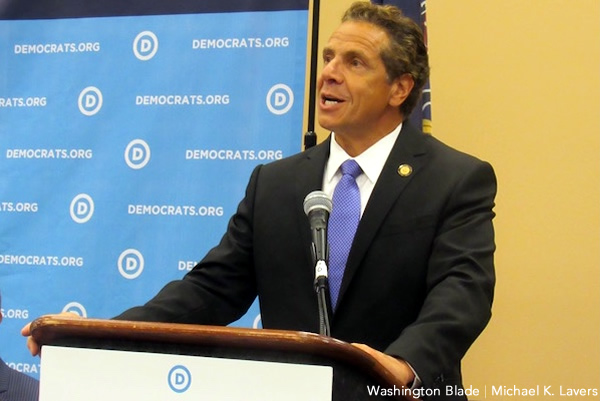Click here to view original web page at www.washingtonblade.com
‘Communities of color have been disproportionately impacted by laws governing marijuana for far too long,’ said Gov. Andrew Cuomo. (Washington Blade file photo by Michael K. Lavers) N.Y. guv signs bill reducing possession penalties ALBANY, N.Y. — Democratic Gov. Andrew Cuomo has signed legislation into law amending marijuana possession […]

‘Communities of color have been disproportionately impacted by laws governing marijuana for far too long,’ said Gov. Andrew Cuomo. (Washington Blade file photo by Michael K. Lavers)
N.Y. guv signs bill reducing possession penalties
ALBANY, N.Y. — Democratic Gov. Andrew Cuomo has signed legislation into law amending marijuana possession penalties and establishing procedures for the automatic expungement of prior, low-level cannabis convictions.
The new law takes effect August 28.
Specifically, Assembly Bill 8420-A reduces the penalty for minor marijuana possession violations (up to one ounce) to a $50 fine. It also amends penalties for offenses involving the possession of more than one ounce but less than two ounces of cannabis from a criminal misdemeanor (punishable by up to three months in jail) to a non-criminal violation punishable by a $200 fine – regardless of an offender’s prior criminal history.
The new law also amends the classification of offenses involving the use or possession of marijuana in public from a criminal misdemeanor, punishable by up to 90 days in jail, to a fine-only offense. In New York City alone, police typically make tens of thousands of marijuana arrests annually under the ‘public view’ exception. Over 87 percent of those charged with the crime are either black or Latino.
Finally, A. 8420-A establishes procedures to allow for the automatic expungement of criminal records specific to crimes involving the possession of 25 grams or less of marijuana. Several hundreds of thousands of New Yorkers will be eligible for expungement under the plan.
“Communities of color have been disproportionately impacted by laws governing marijuana for far too long, and today we are ending this injustice once and for all,” Cuomo said. “By providing individuals who have suffered the consequences of an unfair marijuana conviction with a path to have their records expunged and by reducing draconian penalties, we are taking a critical step forward in addressing a broken and discriminatory criminal justice process.”
Assembly Bill 8420-A was negotiated in the closing days of the 2019 legislative session after lawmakers failed to agree on provisions of a marijuana legalization measure.
U.S. approves increased use of cannabis in research
Federal officials have approved plans for the University of Mississippi to grow 2,000 kilograms (4,409 pounds) of cannabis to provide to investigators for clinical trial research, according to the Associated Press. Since 1968, the University of Mississippi farm, which is governed by the U.S. National Institute on Drug Abuse, has held the only available federal license to legally cultivate cannabis for FDA-approved research in the United States.
According to the AP, marijuana crops will include plants of varying THC and CBD potencies, including strains high in cannabidiol. According to the program’s current marijuana menu, no available samples contain more than seven percent THC and all samples contain less than one percent CBD.
Investigators wishing to conduct FDA-approved clinical trials on cannabis have long complained that federally provided samples are of inferior quality. A research analysis published earlier this year reported that the strains currently available from NIDA shared genetics typically associated with industrial hemp, not commercially available cannabis.
The crop will be the largest grown by the University of Mississippi in several years.
Adolescent pot use not linked to adult brain changes
TEMPE, Ariz. — The use of cannabis during adolescence is not associated with structural brain differences in adulthood, according to longitudinal data published in the journal Drug and Alcohol Dependence.
Investigators from Arizona State University and the University of Pittsburgh assessed the impact of adolescent cannabis exposure on brain morphology in adulthood. Researchers tracked differing adolescent use patterns – from no cannabis use (defined as four days of use or less) to heavy use (defined as, on average, 782 days of use) – in a cohort of 1,000 teenage boys. A subset of participants subsequently underwent structural brain imaging in adulthood (between the ages of 30 to 36). Scientists examined 14 brain regions of interest, including the amygdala and the hippocampus.
Authors reported, “We found that adolescent cannabis use was not associated with adult brain structure in a sample of boys followed prospectively to adulthood.”
They added: “Boys were classified into one of four prototypical adolescent cannabis trajectory subgroups based on prospective assessments of cannabis use frequency from age 13–19: infrequent use/no use, desisting use, escalating use, or chronic-relatively frequent use. … We found no differences in adult brain structure for boys in the different adolescent cannabis trajectory subgroups. Even boys with the highest level of cannabis exposure in adolescence showed subcortical brain volumes and cortical brain volumes and thickness in adulthood that were similar to boys with almost no exposure to cannabis throughout adolescence.”
They concluded, “[T]he patterns of cannabis use typically seen in community-dwelling adolescents does not appear to have lasting effects on brain structure.”
Cannabis Culture news in the Blade is provided in partnership with NORML. Visit norml.org for more information.

